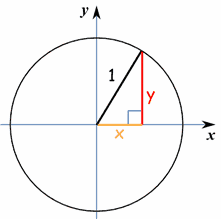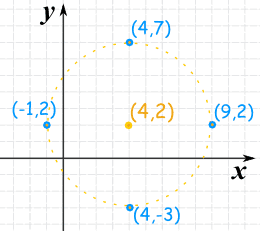Draw an Equation of a Circle
Circumvolve Equations

A circle is easy to make:
Draw a curve that is "radius" away
from a primal point.
And so:
All points are the same distance
from the center.
In fact the definition of a circle is
Circumvolve: The prepare of all points on a plane that are a fixed altitude from a centre.
Circle on a Graph
Allow us put a circle of radius five on a graph:

At present let's piece of work out exactly where all the points are.
We make a right-angled triangle:

So use Pythagoras:
xii + y2 = 52
At that place are an space number of those points, here are some examples:

| x | y | x2 + y2 |
|---|---|---|
| five | 0 | v2 + 02 = 25 + 0 = 25 |
| 3 | 4 | 32 + 42 = ix + 16 = 25 |
| 0 | 5 | 02 + 52 = 0 + 25 = 25 |
| −4 | −3 | (−iv)2 + (−3)ii = sixteen + 9 = 25 |
| 0 | −5 | 02 + (−5)ii = 0 + 25 = 25 |
In all cases a betoken on the circle follows the rule xtwo + ytwo = radius2
We can utilize that idea to detect a missing value
Example: x value of 2, and a radius of 5
Start with: x2 + y2 = r2
Values we know: 22 + y2 = v2
Rearrange: y2 = 52 − ii2
Foursquare root both sides: y = ±√(v2 − 2ii)
Solve: y = ±√21
y ≈ ±4.58...
(The ± means there are ii possible values: 1 with + the other with −)
And here are the two points:

More than Full general Case
Now let u.s.a. put the center at (a,b)

And then the circumvolve is all the points (x,y) that are "r" away from the heart (a,b).
Now lets work out where the points are (using a right-angled triangle and Pythagoras):

It is the same idea as earlier, but we need to subtract a and b:
(x−a)two + (y−b)two = rtwo
And that is the "Standard Class" for the equation of a circle!
It shows all the important information at a glance: the center (a,b) and the radius r.
Example: A circumvolve with eye at (3,four) and a radius of 6:
First with:
(ten−a)two + (y−b)2 = rtwo
Put in (a,b) and r:
(x−3)2 + (y−iv)2 = 62
We can and then utilise our algebra skills to simplify and rearrange that equation, depending on what we need it for.
Effort information technology Yourself
images/circle-equn.js
"Full general Form"
Only you lot may see a circle equation and not know it!
Because information technology may not be in the not bad "Standard Form" above.
As an case, let us put some values to a, b and r and and so aggrandize it
Get-go with: (10−a)2 + (y−b)2 = r2
Example: a=1, b=2, r=3: (x−one)2 + (y−ii)2 = 3ii
Expand: x2 − 2x + one + y2 − 4y + iv = 9
Gather like terms: xii + ytwo − 2x − 4y + ane + iv − nine = 0
And we end up with this:
x2 + y2 − 2x − 4y − iv = 0
It is a circle equation, but "in disguise"!
So when you lot see something like that think "hmm ... that might be a circle!"
In fact we can write it in "Full general Form" by putting constants instead of the numbers:
102 + y2 + Ax + By + C = 0
Annotation: Full general Form always has x2 + y2 for the first ii terms.
Going From General Form to Standard Class
Now imagine we take an equation in Full general Form:
10two + y2 + Ax + Past + C = 0
How can we get it into Standard Form like this?
(10−a)2 + (y−b)ii = rii
The answer is to Consummate the Foursquare (read nearly that) twice ... once for x and in one case for y:
Example: x2 + y2 − 2x − 4y − four = 0
First with: xii + ytwo − 2x − 4y − 4 = 0
Put xs and ys together: (x2 − 2x) + (y2 − 4y) − 4 = 0
Abiding on right: (xii − 2x) + (yii − 4y) = 4
At present consummate the foursquare for x (take half of the −two, square it, and add together to both sides):
(ten2 − 2x + (−ane)two ) + (y2 − 4y) = 4 + (−one)2
And complete the square for y (take half of the −4, square it, and add to both sides):
(102 − 2x + (−one)2) + (y2 − 4y + (−2)two ) = four + (−one)2 + (−2)2
Tidy up:
Simplify: (xtwo − 2x + 1) + (y2 − 4y + 4) = 9
Finally: (ten − one)2 + (y − two)2 = threetwo
And we take it in Standard Form!
(Note: this used the a=i, b=2, r=iii example from before, and so we got it right!)
Unit of measurement Circumvolve
If we place the circumvolve heart at (0,0) and set the radius to one we go:
 | (x−a)ii + (y−b)two = rii (x−0)two + (y−0)two = onetwo x2 + y2 = 1 Which is the equation of the Unit Circle |
How to Plot a Circle by Hand
1. Plot the heart (a,b)
ii. Plot 4 points "radius" away from the eye in the upwardly, downward, left and right management
3. Sketch it in!
Example: Plot (x−4)ii + (y−two)2 = 25
The formula for a circle is (x−a)2 + (y−b)2 = r2
So the center is at (4,two)
And r2 is 25, then the radius is √25 = 5

Then we tin can plot:
- The Centre: (4,2)
- Up: (iv,2+five) = (iv,7)
- Down: (four,ii−5) = (four,−3)
- Left: (four−5,2) = (−1,2)
- Correct: (4+5,2) = (9,ii)
Now, just sketch in the circle the all-time we tin can!
How to Plot a Circle on the Figurer
We need to rearrange the formula and so nosotros go "y=".
Nosotros should end up with two equations (top and bottom of circle) that can then be plotted.
Instance: Plot (x−4)2 + (y−ii)2 = 25
And then the centre is at (4,ii), and the radius is √25 = v
Rearrange to go "y=":
Showtime with: (10−four)ii + (y−2)2 = 25
Movement (x−4)2 to the right: (y−two)two = 25 − (x−4)2
Accept the foursquare root: (y−2) = ± √[25 − (ten−4)two]
(notice the ± "plus/minus" ...
there can be two square roots!)
Motion the "−two" to the right: y = 2 ± √[25 − (10−4)2]
So when we plot these two equations nosotros should take a circle:
- y = 2 + √[25 − (10−iv)2]
- y = two − √[25 − (10−4)2]
Try plotting those functions on the Function Grapher.
Information technology is also possible to use the Equation Grapher to practise it all in one go.
8526, 8527, 8539, 8540, 8515, 8516, 569, 8544, 8559, 8560, 570, 1209
Source: https://www.mathsisfun.com/algebra/circle-equations.html
0 Response to "Draw an Equation of a Circle"
Post a Comment